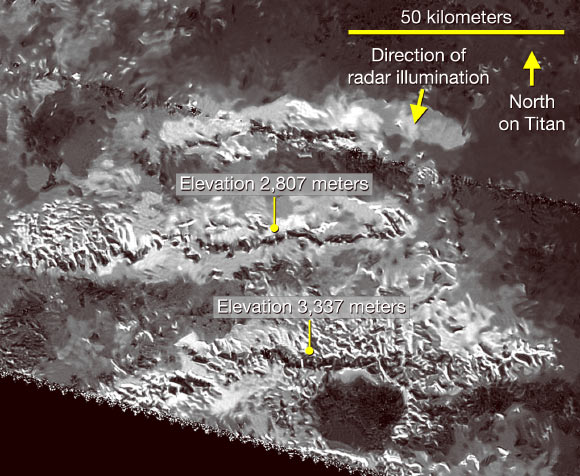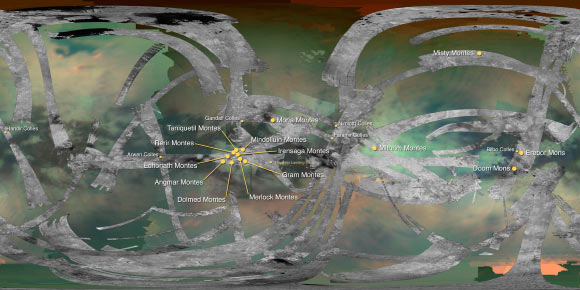Planetary researchers with NASA’s Cassini mission have identified the highest point on Titan, the largest moon of Saturn.

Titan’s Mithrim Montes is home to the hazy moon’s tallest peak. Image credit: NASA / JPL-Caltech / ASI.
A trio of mountainous ridges called the Mithrim Montes is home to Titan’s tallest peak.
The mountain, which has an elevation of 10,948 feet (3,337 m), is located midway along the lower of the three ridges shown in the radar image above.
“It’s not only the highest point we’ve found so far on Titan, but we think it’s the highest point we’re likely to find,” said team member Dr. Stephen Wall, from NASA’s Jet Propulsion Laboratory.
Dr. Wall and his colleagues used images and other data from Cassini’s radar instrument, which can peer through the obscuring smog of Titan’s atmosphere to reveal the surface in detail.
“Radar images do not present scenes as they would appear to human eyes,” the scientists explained.
“Instead of sunlight, radar images use radio waves beamed by the spacecraft that are reflected and scattered off of Titan’s surface in order to see through Titan’s opaque atmosphere.”
“Bright regions indicate materials that are rough or that otherwise scatter the beam; dark regions indicate materials that are relatively smooth or that otherwise absorb radar waves.”
According to the researchers, most of Titan’s tallest mountains appear to be close to the equator.
They identified other peaks of similar height within the Mithrim Montes, as well as in the rugged region known as Xanadu, and in collections of more isolated peaks called ‘ridge belts.’

This map of Titan identifies the locations of mountains that have been named by the International Astronomical Union. By convention, mountains on Titan are named for mountains from Middle-earth, the fictional setting in fantasy novels by J.R.R. Tolkien. Colles (collections of hills) are named for characters from the same works by Tolkien. The map uses data collected by both Cassini’s visual and infrared mapping spectrometer (VIMS) and radar instruments. Image credit: NASA / JPL-Caltech / University of Arizona / USGS.
Cassini has found that Titan also has rain and rivers that erode its landscape.
“The process probably proceeds much more slowly on Titan than on Earth because, at ten times Earth’s distance from the Sun, there is less energy to power erosive processes in the moon’s atmosphere,” said team member Dr. Jani Radebaugh, from Brigham Young University.
Titan’s icy crust sits atop a deep ocean of liquid water that probably acts much like Earth’s upper mantle.
Once a period of mountain-building ends, these fluid layers – Earth’s upper mantle and Titan’s liquid ocean – allow the crust to relax. Also, at great depth, the water-ice bedrock of Titan is softer than rock on Earth.
Because of these characteristics, scientists didn’t expect mountains on Titan would tower quite as high as those on Earth.
The fact that Titan has significant mountains at all suggests that some active tectonic forces could be affecting the surface, for example, related to Titan’s rotation, tidal forces from Saturn or cooling of the crust.
The findings were presented March 24, 2016, at the 47th annual Lunar and Planetary Science Conference at The Woodlands, Texas.
The next step for the team will be trying to figure out what could produce such tall peaks on Titan.
_____
Jani Radebaugh et al. 2016. The Highest Point on Titan. 47th annual Lunar and Planetary Science Conference, abstract # 2694
R.D. Lorenz et al. 2016. The Edge of Xanadu : Investigation with Altimetry and Nadir Emissivity. 47th annual Lunar and Planetary Science Conference, abstract # 1910
Grima C. et al. 2016. Radar Statistical Reconnaissance with the Cassini RADAR: Roughness of Titan’s Seas. 47th annual Lunar and Planetary Science Conference, abstract # 1660







